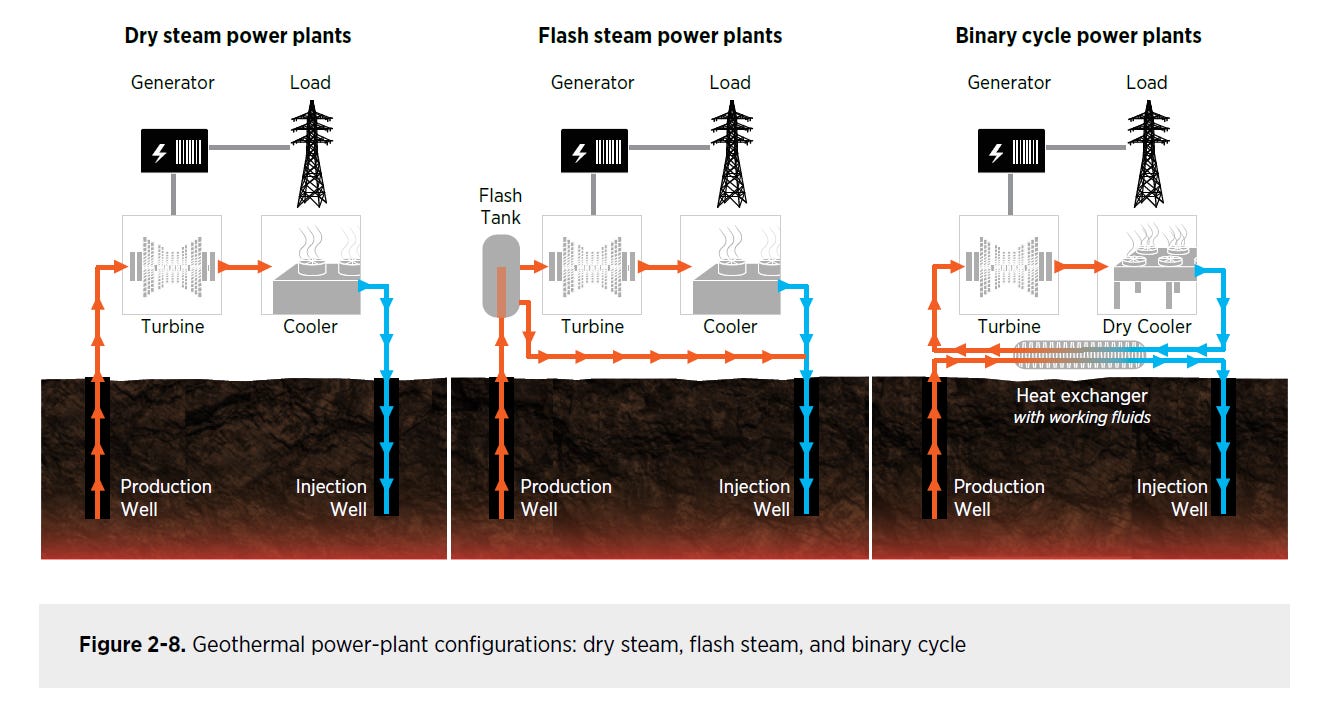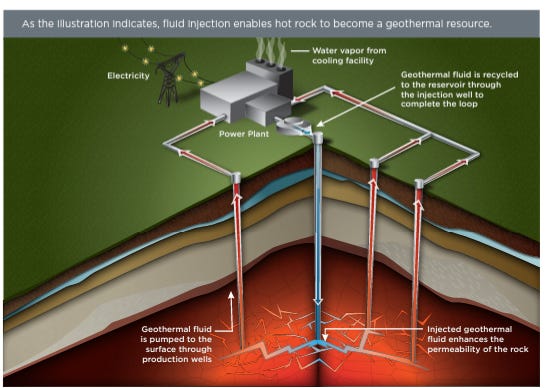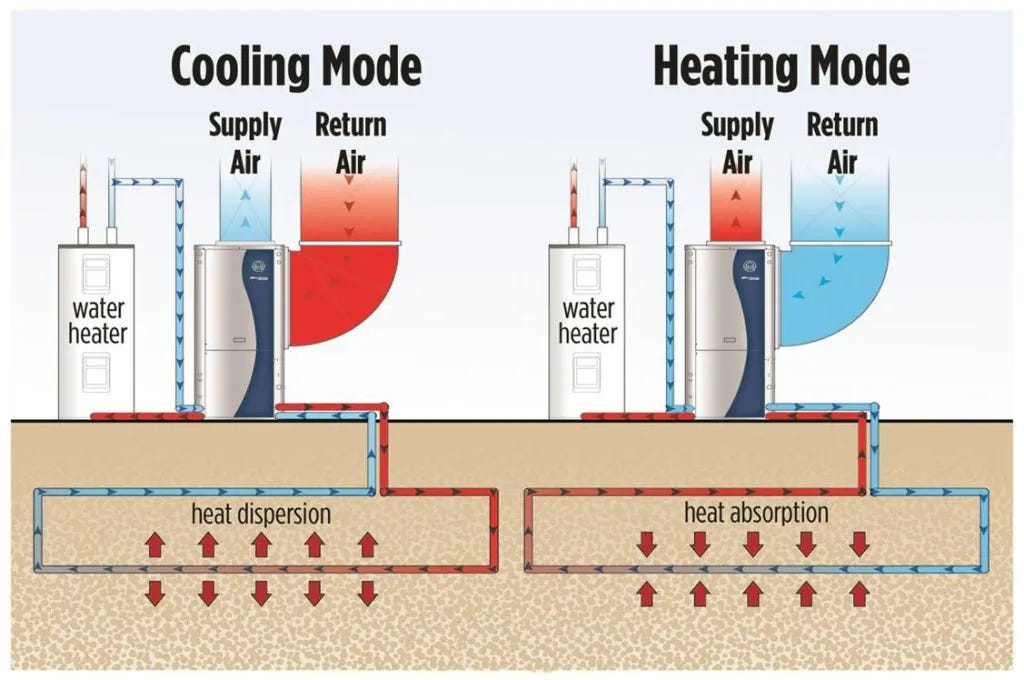🌋 Introduction to Geothermal Energy
Learn the history behind this century-old technology and the innovations making it a terawatt-scale climate solution. Access the open Geothermal Energy Landscape database.
In the world of renewable energy, wind and solar receive the lion’s share of attention and support. Yet as important as these technologies are to the clean energy transition, there is another resource that could provide terawatts of clean energy while addressing some of the challenges currently faced by the renewable energy sector.
Read on for a look at geothermal energy and emerging technologies to harness the energy deep beneath our feet. Our next edition will dive deeper into the benefits and risks of geothermal, so be sure to subscribe to follow along.
Read Part 2: The Realities of Geothermal Energy
Don’t miss our open landscape database of innovators and learning resources.
Geothermal Energy Primer
Contributed by Hannah Bercovici, a writer based in Phoenix, Arizona. She/they writes about a variety of topics, from environmental justice to problem-solving technologies.
Tapping into the massive amount of heat stored in the Earth’s crust, natural geothermal resources provide a steady supply of energy in the form of heat. And unlike solar and wind, geothermal can be a near-constant source of energy and doesn’t depend on weather conditions to work. This makes it an effective form of baseload power, meaning that it can supply consistent electricity to the grid.
Geothermal can also be used directly to heat and cool buildings by using heat pumps. Around the world, people, governments, and industries are switching to geothermal heating and cooling systems, both for the environment and lower costs. In some cases, the heat can be used directly in industrial processes, bypassing the need to burn fossil fuels.
Although geothermal has been used in some manner for over a century, our ability to tap into it has been constrained to relatively few locations. Traditional geothermal plants require reservoirs of naturally heated water or steam to work. These tend to be located near volcanically active areas — which obviously aren’t everywhere. In order to access the full range of geothermal resources, we need to dig deeper into hotter rock than ever before.
In the past few decades, geothermal technology has improved as other sectors (cough cough, oil and gas) have improved methods for drilling deep into the earth. Through government subsidies and incredible research, different players have uncovered an entirely new class of super-hot rock deep below us, ushering in a new generation of geothermal technology.
Conventional Approaches to Geothermal
When you think of geothermal energy, conventional plants are the ones that likely come to mind. Conventional geothermal plants use hydrothermal resources (aka water or steam reservoirs) to power a turbine and produce energy.
They require tectonically active areas that naturally produce steam, such as rift valleys, hotspots, and subduction zones. Magma and magma chambers heat up nearby rock, which then heats up nearby water reservoirs.

The first kind of the geothermal plant ever developed were dry steam geothermal plants. They are highly efficient… and rare. These require access to a steam reservoir, naturally heated between 360-700°F. The steam is pulled up through a well and then drives a turbine. It is then condensed and injected back into the steam reservoir, ideally.
While this is the simplest design of all the conventional geothermal plants, it is also the rarest. In fact, only two possible locations exist in the U.S. — The Geysers in California and Yellowstone National Park.
If dry steam plants are the simplest form of hydrothermal energy, flash steam geothermal plants are the next step up in complexity. In this case, the water reservoir doesn’t need to be hot enough to produce steam. Instead, power plants pull hot water from its reservoir and, using a flash tank and lower pressure, convert it into steam to drive the turbine. Once used, the steam is condensed back into water and returned to its reservoir. Still rare, flash steam geothermal plants are a lot more common than dry steam.
Finally, binary cycle power plants are the most common (and complicated) conventional geothermal energy. Like flash steam, they require a hot water reservoir. Unlike the other two conventional types, binary cycle plants can utilize water that is as cool as 225°F. Using pipes, they expose a secondary fluid (usually a hydrocarbon) with a low boiling point to the hot water. The secondary fluid turns into steam and runs the turbine, while the water is piped elsewhere or returned to the reservoir.
Conventional Geothermal Developers & Operators
In the U.S., Calpine has developed multiple dry steam facilities around The Geysers in California.
In Italy, the oldest dry steam geothermal plant (circa 1904) is still operated by Enel Green Power.
Ormat Technologies has built flash steam and binary cycle power plants in the U.S., Kenya, Indonesia, and many more regions.
Toshiba develops flash steam power plants globally. For example, Toshiba is working with Tanzania Geothermal Development Company to develop more geothermal plants in Tanzania.
Check out the ThinkGeoEnergy map for a comprehensive look
Enhanced Geothermal Systems
Enhanced Geothermal Systems (EGS) are fairly new and do not require volcanically active areas to work. They do, however, require access to hot basement rock. Basement rock is the foundation of the continental crust, which make up… Well, continents. It can be over 20 miles thick, though you can actually see basement rock in places like the Grand Canyon.
But we’re not interested in the basement rock on the surface — we want the basement rock buried underneath miles of sediments, hot from both the pressure above and the mantle below. The ideal basement rock should also not contain or absorb any liquid, lovingly referred to as “hot, dry rock.” You can find this almost anywhere — if you dig deep enough.
A well is drilled over 2 miles deep through the sedimentary layer until it hits the hot basement rock. Water is injected into the well to fracture or follow existing fractures. These fractures widen, creating a water reservoir deep in the hot crust. As fractures are extended and water is heated, more wells are drilled to intersect the stimulated fracture system. The heated water is pumped up to the surface, used to power turbines, and re-injected into artificial reservoirs.
This method isn’t without its challenges. New technologies must be developed to enable the drilling, pumping, and monitoring of these harsh environments. A future article will cover some of these technologies in depth.
EGS Innovators
Fervo uses geoscientific instrumentation to measure and monitor geothermal assets.
GreenFire Energy has developed multiple technologies for EGS.
Quaise Energy is an MIT spinout developing novel drilling technologies.
The U.S. Department of Energy is pushing more groups to research EGS in their Frontier Observatory for Research in Geothermal Energy (FORGE) Initiative.
Geothermal Heat Pumps
As you may know if you’ve walked barefoot on the sidewalk in August in Arizona (or is that just me?), the surface temperature of the ground changes with the season. Luckily for us, rocks are pretty bad at conducting heat. So if you go a couple of feet underground, you’ll find that the ground is a reasonable temperature (typically between 45-75°F) throughout the year. Therefore, the ground can act as a heat source or sink.
Geothermal heat pumps do not produce electricity — instead, they equilibrate a building’s temperature with the temperature below. Typically, companies install a series of pipe loops 4-6 feet underground. Then they pump liquid (usually water and antifreeze) through the pipes, which is used by a heat pump to heat or cool the air depending on the relative temperature difference.
Geothermal heat pumps can also be used in large-scale industrial or district heating systems and homes and commercial buildings. For example, the city of Ithaca in New York have been utilizing heat pumps in their Youth Bureau building since 1996. Individuals, industries, and cities can utilize geothermal heat pumps to save money and help the planet.
Geothermal Heat Pump Companies
Dandelion Energy in the East Coast has provided thousands of households with geothermal heating and cooling systems, cutting their energy bills by 47%.
Similarly, St1 operates in Finland installing geothermal heat pumps.
The Geothermal Potential
"The future is bright [for geothermal].” — Hidda Thorsteinsson of Inagi
So what does a world with more geothermal energy look like?
Imagine local transportation and electric cars powered by the heat beneath your feet. You walk into your house and it’s always at a cool 73°F. Your spouse comes home from their job as a lawyer for the local geothermal plant. You step outside and take a deep breath without coughing because well… the air is clean.
The best part? You don’t need to worry about where your energy comes from. Because you know where it’s from — the Earth.
Additional Learning Resources
✨ Geothermal Energy Landscape database
📔 GeoVision: Harnessing the Heat Beneath Our Feet
🔉 Switched ON Podcast: The Business Case for Geothermal (part 2)
📺 TED-Ed: Iceland's Secret Power
🗺️ Think GeoEnergy Power Plant Map
Up Next
In the next edition in our Geothermal Energy series we’ll dive deep into the benefits and risks of geothermal, including the environmental justice issues already faced by some communities.
Let us know what you’re interested in learning about next by voting in the poll below.






